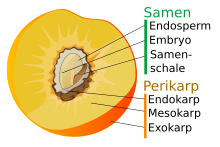pericarp


A pericarp (from ancient Greek περί perí "around ..." and καϱπός karpós "fruit") is the fruit casing or pericarp in seed plants .
The development of a fruit begins after the seeds have been fertilized; the fruit is thus the flower in the state of seed ripeness, in which the flower organs with the exception of the gynoeceum (the female sexual organ of the flower, i.e. the totality of the carpels) perish. The gynoeceum wall becomes the pericarp, also called pericarp, during fruit formation. According to the properties of a pericarp in the ripe fruits, a distinction is made between opening , decaying or closing fruits .
The inner epidermis of the pericarp is referred to as the endocarp , the outer epidermis as the exocarp or epicarp , in between lies the mesocarp , if it is fleshy or juicy, the pulp is also sarcocarp , in citrus fruits it is also known as albedo (from Latin albedo " white color, the “white”).
These layers can be equally pronounced, for example dry-skinned on the follicle fruit , lignified on the nut fruit or fleshy on the berry ; or they are different, as in the case of the stone fruit . Here the lignified core surrounding the seed represents the endocarp, the pulp the mesocarp and the overlying skin the exocarp.
Web links
- Spongy ballast. Is the white stuff on the tangerine harmful? - Zeit Online Wissen Is it true about the mandarin mesocarp from February 7, 2008